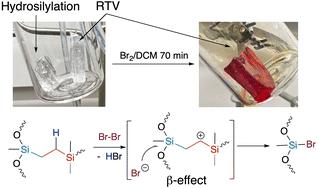当前位置:
X-MOL 学术
›
Polym. Chem.
›
论文详情
Our official English website, www.x-mol.net, welcomes your feedback! (Note: you will need to create a separate account there.)
Selective oxidative devulcanization of hydrosilylation-cured silicone elastomers: enhanced circularity
Polymer Chemistry ( IF 4.6 ) Pub Date : 2024-02-26 , DOI: 10.1039/d3py01431b Muhammad Ebad Noman 1 , Massandje K. Bayo 1 , Yang Chen 1 , Michael A. Brook 1
Polymer Chemistry ( IF 4.6 ) Pub Date : 2024-02-26 , DOI: 10.1039/d3py01431b Muhammad Ebad Noman 1 , Massandje K. Bayo 1 , Yang Chen 1 , Michael A. Brook 1
Affiliation

|
In commerce, silicone elastomers are typically cured by platinum-catalyzed hydrosilylation or radical induced crosslinking (high temperature vulcanization (HTV)), both of which lead to crosslinks comprised of 2 or 3 carbon fragments. Alternatively, room temperature vulcanization (RTV) utilizes catalyzed nucleophilic substitution to give elastomers with Si–O–Si crosslinks. At end of life, the best current recycling protocols use aggressive acid/base conditions to regenerate cyclic monomers and mixtures of crosslinkers/fillers, etc. Over longer time periods all three types of elastomers undergo acid-catalyzed depolymerization initiated by HBr derived from bromine. However, we report that oxidative de-crosslinking with bromine of the Pt-cured elastomers occurs in minutes to hours to regenerate long chain silicone polymers, terminated with SiOH groups. It is therefore possible to devulcanize Pt-cured elastomers in the presence of RTV elastomers and reuse the high molar mass materials directly in new RTV elastomers, avoiding complete depolymerization, and thereby increasing the circularity of silicones.
中文翻译:

氢化硅烷化固化有机硅弹性体的选择性氧化脱硫:增强圆度
在商业中,有机硅弹性体通常通过铂催化的硅氢加成或自由基诱导交联(高温硫化 (HTV))进行固化,这两种方法都会产生由 2 或 3 个碳片段组成的交联。或者,室温硫化 (RTV) 利用催化亲核取代来产生具有 Si-O-Si 交联的弹性体。在使用寿命结束时,当前最好的回收方案使用侵蚀性酸/碱条件来再生环状单体和交联剂/填料的混合物等。经过较长时间,所有三种类型的弹性体都会经历由溴衍生的 HBr 引发的酸催化解聚。然而,我们报告说,铂固化弹性体的溴氧化脱交联在几分钟到几小时内发生,以再生出以 SiOH 基团封端的长链有机硅聚合物。因此,可以在 RTV 弹性体存在的情况下对 Pt 固化弹性体进行脱硫,并将高摩尔质量材料直接重新用于新的 RTV 弹性体中,避免完全解聚,从而提高有机硅的圆形度。
更新日期:2024-02-28
中文翻译:

氢化硅烷化固化有机硅弹性体的选择性氧化脱硫:增强圆度
在商业中,有机硅弹性体通常通过铂催化的硅氢加成或自由基诱导交联(高温硫化 (HTV))进行固化,这两种方法都会产生由 2 或 3 个碳片段组成的交联。或者,室温硫化 (RTV) 利用催化亲核取代来产生具有 Si-O-Si 交联的弹性体。在使用寿命结束时,当前最好的回收方案使用侵蚀性酸/碱条件来再生环状单体和交联剂/填料的混合物等。经过较长时间,所有三种类型的弹性体都会经历由溴衍生的 HBr 引发的酸催化解聚。然而,我们报告说,铂固化弹性体的溴氧化脱交联在几分钟到几小时内发生,以再生出以 SiOH 基团封端的长链有机硅聚合物。因此,可以在 RTV 弹性体存在的情况下对 Pt 固化弹性体进行脱硫,并将高摩尔质量材料直接重新用于新的 RTV 弹性体中,避免完全解聚,从而提高有机硅的圆形度。



























 京公网安备 11010802027423号
京公网安备 11010802027423号